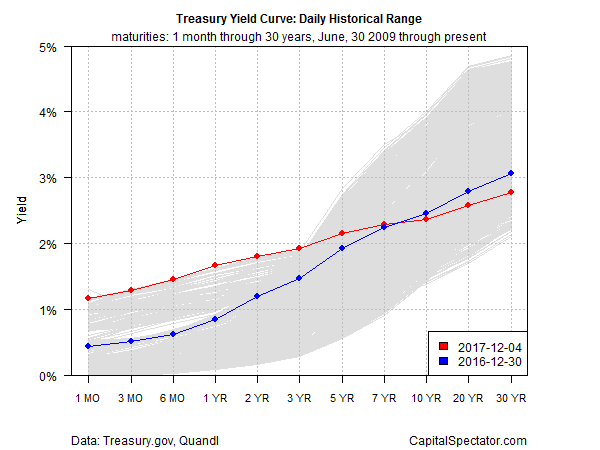The gap between the 10-year and 2-year Treasury yields fell to 57 basis points on Monday (December 4), according to Treasury.gov’s daily data. The dip marks yet another post-recession low for this widely monitored spread. The flattening of the yield curve implies that the economy is facing stronger headwinds, based on the spread’s history vis-à-vis the US business cycle. But the macro trend remains solid at the moment, suggesting that the 10-year/2-year yield gap has shed its value, at least temporarily, as an early warning of US recession risk.
Whatever the outlook for the economy, the source of the sliding 10-year/2-year spread is clear. The rate for the shorter maturity has been consistently rising since September, driven by growing confidence that the Federal Reserve will continue to raise interest rates. The 2-year rate ticked up on Monday to 1.80%, the highest since the recession ended in mid-2009. Meanwhile, the benchmark 10-year yield has been more or less flat in recent months, holding in a range of roughly 2.20% to 2.40% — below this year’s 2.62% peak in May.

Meanwhile, next week’s Fed meeting is expected to deliver another round of tighter monetary policy. The futures market for Feds funds is currently projecting an implied 90% probability that the central bank will announce a rate hike on December 13, according to CME data. If the forecast is right, the Fed funds target rate will rise 25 basis points to a 1.25%-1.50% range, the highest since 2008.
The general flattening of the Treasury yield curve is conspicuous this year for all maturities up through the 5-year rate.

History suggests that a narrowing yield spread is a warning sign for the economy, particularly if the curve inverts (short rates above long rates). The 10-year/2-year spread is still positive, but with less than 60 basis points to go before inversion this spread could go negative in the near term if current trend persists.
Recession risk, however, remains virtually nil at the moment. Although the future’s forever uncertain, a broad set of indicators points to a low probability that an NBER-defined downturn has started or is about to start.
Blackrock) agrees, advising on Monday:
The US Treasury yield curve has flattened for much of 2017, and spreads between long and short maturities recently narrowed to decade lows. This is usually a late-cycle phenomenon indicating flagging growth – but not this time around, in our view.
The reasoning: signs of economic growth are conspicuous. “We see a sustained global and U.S. economic expansion,” notes Blackrock). Why, then, is the yield curve continuing to flatten?
Much of this year’s earlier yield curve flattening represented a reversal of the 2016 steepening that accompanied surging economic growth and inflation expectations after the U.S. presidential election. Markets had bet that fiscal stimulus and infrastructure spending would spur growth and inflation. Long-term yields jumped in response. Those market expectations unwound over the course of 2017 when policy changes were slow to materialize and weak inflation readings became the big surprise. Persistent demand for long-term Treasuries pushed 30-year yields lower even as short-term rates rose. We could see long-term Treasuries rising a bit from here — but expect low-trend growth, plentiful global savings seeking income and other structural factors to keep them historically low.
David Sekera, Morningstar’s managing director of corporate bond ratings and research, is also skeptical that the narrowing yield spread is a worrisome sign for the economy.
In the past, when the yield curve has been flattening, it has often been an indicator of a weakening economy and in many cases portended a recession. This time around, this signal may not be foreshadowing a recession, as it is being heavily influenced by global central bank actions.
In particular, the combination of a Fed that’s intent on raising short rates and ongoing quantitative easing by foreign central banks – in Europe and Japan, specifically – has kept global demand high for long rates, including the US 10-year yield, Sekera reasons. As a result, the 10-year rate has been relatively stable. “Even though the 10-year U.S. Treasury is yielding only 2.36%, that yield is attractive to global bond investors as the yield on Germany’s 10-year bond is 0.31% and the yield on Japan’s 10-year bond is barely positive at 0.04%,” he writes.
Meantime, several estimates for US Q4 GDP growth remain upbeat. The Atlanta Fed’s GDPNow model is currently projecting a strong 3.5% rise (December 1) and the NY Fed’s latest estimate is even higher at 3.9% (December 1).
The upbeat macro profile could change, of course, and perhaps quickly. But using the numbers in hand right now doesn’t support the dark signals emanating from the Treasury curve. Until we see signs of deterioration in the data beyond the yield curve, it’s prudent to assume that the Treasury spread is sending a false signal about the business cycle.
